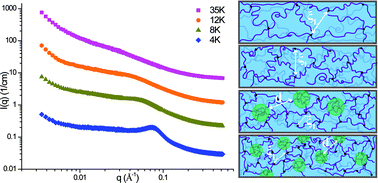SANS study of highly resilient poly(ethylene glycol) hydrogels
Abstract
Polymer networks are critically important for numerous applications including soft biomaterials, adhesives, coatings, elastomers, and gel-based materials for energy storage. One long-standing challenge these materials present lies in understanding the role of network defects, such as dangling ends and loops, developed during cross-linking. These defects can negatively impact the physical, mechanical, and transport properties of the gel. Here we report chemically cross-linked poly(ethylene glycol) (PEG) gels formed through a unique cross-linking scheme designed to minimize defects in the network. The highly resilient mechanical properties of these systems (discussed in a previous publication) [J. Cui, M. A. Lackey, A. E. Madkour, E. M. Saffer, D. M. Griffin, S. R. Bhatia, A. J. Crosby and G. N. Tew, Biomacromolecules, 2012, 13, 584–588], suggests that this cross-linking technique yields more homogeneous network structures. Four series of gels were formed based on chains of 35 000 g mol−1, (35k), 12 000 g mol−1 (12k) g mol−1, 8000 g mol−1 (8k) and 4000 g mol−1 (4k) PEG. Gels were synthesized at five initial polymer concentrations ranging from 0.077 g mL−1 to 0.50 g mL−1. Small-angle neutron scattering (SANS) was utilized to investigate the network structures of gels in both D2O and d-DMF. SANS results show the resulting network structure is dependent on PEG length, transitioning from a more homogeneous network structure at high molecular weight PEG to a two phase structure at the lowest molecular weight PEG. Further investigation of the transport properties inherent to these systems, such as diffusion, will aid to further confirm the network structures.


 Please wait while we load your content...
Please wait while we load your content...